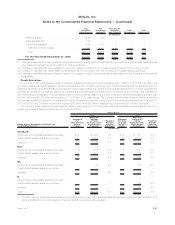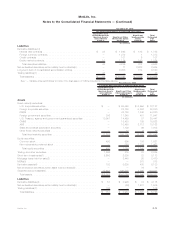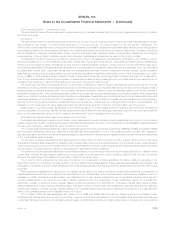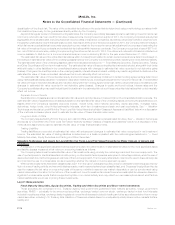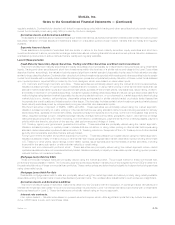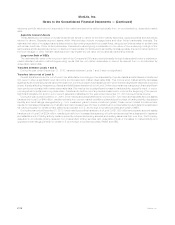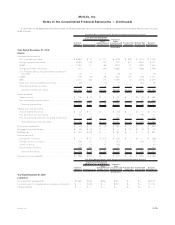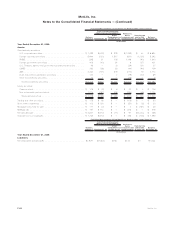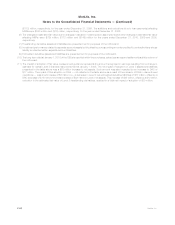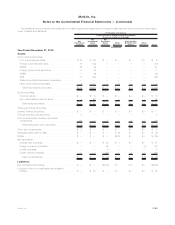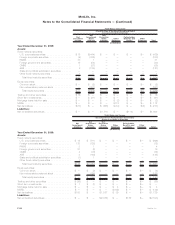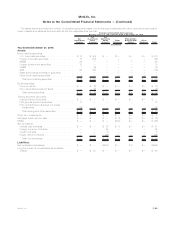MetLife 2010 Annual Report Download - page 164
Download and view the complete annual report
Please find page 164 of the 2010 MetLife annual report below. You can navigate through the pages in the report by either clicking on the pages listed below, or by using the keyword search tool below to find specific information within the annual report.regularly available. Contractholder-directed unit-linked investments reported within trading and other securities include certain registered
mutual fund interests priced using daily NAV provided by the fund managers.
Derivative Assets and Derivative Liabilities
These assets and liabilities are comprised of exchange-traded derivatives, as well as interest rate forwards to sell certain to be announced
securities. Valuation of these assets and liabilities is based on unadjusted quoted prices in active markets that are readily and regularly
available.
Separate Account Assets
These assets are comprised of securities that are similar in nature to the fixed maturity securities, equity securities and short-term
investments referred to above; and certain exchange-traded derivatives, including financial futures and owned options. Valuation is based on
unadjusted quoted prices in active markets that are readily and regularly available.
Level 2 Measurements:
Fixed Maturity Securities, Equity Securities, Trading and Other Securities and Short-term Investments
This level includes fixed maturity securities and equity securities priced principally by independent pricing services using observable
inputs. Trading and other securities and short-term investments within this level are of a similar nature and class to the Level 2 securities
described below; accordingly, the valuation techniques and significant market standard observable inputs used in their valuation are also
similar to those described below. Contractholder-directed unit-linked investments reported within trading and other securities include certain
mutual fund interests without readily determinable fair values given prices are not published publicly. Valuation of these mutual funds is based
upon quoted prices or reported NAV provided by the fund managers, which were based on observable inputs.
U.S. corporate and foreign corporate securities. These securities are principally valued using the market and income approaches.
Valuation is based primarily on quoted prices in markets that are not active, or using matrix pricing or other similar techniques that use
standard market observable inputs such as a benchmark yields, spreads off benchmark yields, new issuances, issuer rating, duration,
and trades of identical or comparable securities. Investment grade privately placed securities are valued using a discounted cash flow
methodologies using standard market observable inputs, and inputs derived from, or corroborated by, market observable data including
market yield curve, duration, call provisions, observable prices and spreads for similar publicly traded or privately traded issues that
incorporate the credit quality and industry sector of the issuer. This level also includes certain below investment grade privately placed
fixed maturity securities priced by independent pricing services that use observable inputs.
Structured securities comprised of RMBS, CMBS and ABS. These securities are principally valued using the market approach.
Valuation is based primarily on matrix pricing or other similar techniques using standard market inputs including spreads for actively
traded securities, spreads off benchmark yields, expected prepayment speeds and volumes, current and forecasted loss severity,
rating, weighted average coupon, weighted average maturity, average delinquency rates, geographic region, debt-service coverage
ratios and issuance-specific information including, but not limited to: collateral type, payment terms of the underlying assets, payment
priority within the tranche, structure of the security, deal performance and vintage of loans.
U.S. Treasury, agency and government guaranteed securities. These securities are principally valued using the market approach.
Valuation is based primarily on quoted prices in markets that are not active, or using matrix pricing or other similar techniques using
standard market observable inputs such as benchmark U.S. Treasury yield curve, the spread off the U.S. Treasury curve for the identical
security and comparable securities that are actively traded.
Foreign government and state and political subdivision securities. These securities are principally valued using the market approach.
Valuation is based primarily on matrix pricing or other similar techniques using standard market observable inputs including benchmark
U.S. Treasury or other yields, issuer ratings, broker-dealer quotes, issuer spreads and reported trades of similar securities, including
those within the same sub-sector or with a similar maturity or credit rating.
Common and non-redeemable preferred stock. These securities are principally valued using the market approach where market
quotes are available but are not considered actively traded. Valuation is based principally on observable inputs including quoted prices in
markets that are not considered active.
Mortgage Loans Held by CSEs
These commercial mortgage loans are principally valued using the market approach. The principal market for these commercial loan
portfolios is the securitization market. The Company uses the quoted securitization market price of the obligations of the CSEs to determine
the estimated fair value of these commercial loan portfolios. These market prices are determined principally by independent pricing services
using observable inputs.
Mortgage Loans Held-For-Sale
Residential mortgage loans held-for-sale are principally valued using the market approach and valued primarily using readily available
observable pricing for similar loans or securities backed by similar loans. The unobservable adjustments to such prices are insignificant.
Derivative Assets and Derivative Liabilities
This level includes all types of derivative instruments utilized by the Company with the exception of exchange-traded derivatives and
interest rate forwards to sell certain to be announced securities included within Level 1 and those derivative instruments with unobservable
inputs as described in Level 3. These derivatives are principally valued using an income approach.
Interest rate contracts.
Non-option-based — Valuations are based on present value techniques, which utilize significant inputs that may include the swap yield
curve, LIBOR basis curves, and repurchase rates.
F-75MetLife, Inc.
MetLife, Inc.
Notes to the Consolidated Financial Statements — (Continued)




